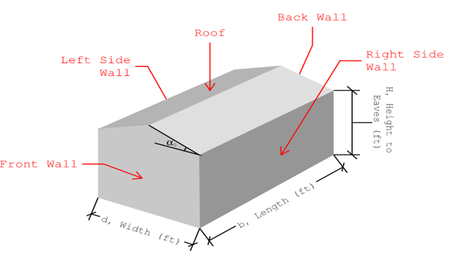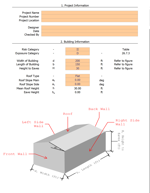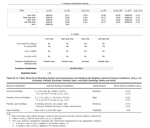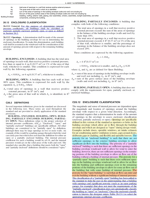Wind Enclosure Classification (ASCE 7 - 16)

Description
Determine enclosure classification for regular, rectangular shaped building with flat or gable roof. Able to enter in pre-defined opening shapes or custom shape by area of opening. Enter in custom values into orange shaded cells.
The American Society of Civil Engineers (ASCE) has published a standard called ASCE 7-16 'Minimum Design Loads and Associated Criteria for Buildings and Other Structures,' which provides guidelines for calculating design loads for various types of structures. One of the critical aspects covered in this standard is wind loads, and as part of the wind load provisions, the ASCE 7-16 introduced the Wind Enclosure Classification. The classification is used to categorize buildings and structures based on their openings and potential for internal pressurization during wind events.
Wind Enclosure Classification in ASCE 7-16 divides structures into three categories:
-
Enclosed Building (Type E): An enclosed building is a structure that has no openings larger than the sum of the areas of openings that allow air to flow through. The total area of openings in the building's walls should not exceed 4% of the gross area of the walls. In this type of building, the internal pressure is relatively small, and the structure is designed to resist the external wind pressure only.
-
Partially Enclosed Building (Type PE): A partially enclosed building has openings larger than what is defined for enclosed buildings but less than what is defined for open buildings. In these structures, the internal pressure can be significant, and the design must consider both the internal and external wind pressures. The total area of openings should be between 4% and 20% of the gross area of the walls.
-
Open Building (Type O): An open building is a structure where the total area of openings in the walls is equal to or greater than 20% of the gross area of the walls. In these buildings, the internal pressure is assumed to be equal to the external pressure, and the design must consider the combined effect of both internal and external pressures.
The Wind Enclosure Classification is essential for determining the wind pressures acting on a building and its components, such as cladding, windows, and doors. By properly classifying a structure, engineers can ensure that it is designed to withstand the wind forces it will experience throughout its service life.
Calculation Preview
Full download access to any calculation is available to users with a paid or awarded subscription (XLC Pro).
Subscriptions are free to contributors to the site, alternatively they can be purchased.
Click here for information on subscriptions.




